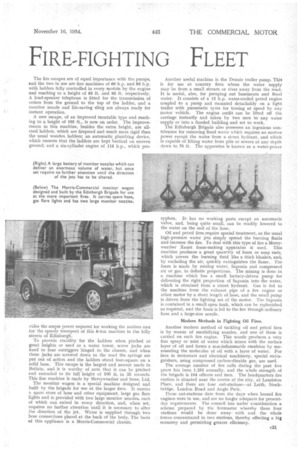FIRE-FIGHTING FLEET
Page 97

If you've noticed an error in this article please click here to report it so we can fix it.
The fire escapes are of equal importance with the pumps, and the two in use are fine machines of 60 h.p. and 80 h.p. with ladders fully controlled in every motidn by the engine and reaching to a height of 85 ft. and 95 ft. respectively. A loud-speaker telephone is fitted for the transmission of orders from the ground to the top of the ladder, and a monitor nozzle and life-saving sling are always ready for . instant operation.
A new escape, of an improved turntable type and reaching to a height of 105 ft., is now on order. The improvements in this machine, besides the extra height, are allsteel ladders, which are fireproof and much more rigid than the usual wooden ladders; an automatic plumbing device, which ensures that the ladders are kept Ciertical on uneven ground; and a six-cylinder engine of 115 which pro vides the ample power required for working the ladders and for the speedy transport of this 8-ton machine in the hilly streets of Edinburgh.
To provide stability for the ladders when pitched at great heights or used as a water tower, screw jacks are fixed to four outriggers hinged to the chassis, and when these jacks are screwed down to the road the springs are put out of action and the ladders stand four-square on a solid base. This escape is the largest and newest made in Britain, and it is worthy of note that it can be pitched and extended to its full height of 105 ft. in 35 seconds. This fine machine is made by Merryweather and Sons, Ltd.
The monitor wagon is a special machine designed and built by the brigade for use at the larger fires. It carries a spare store of hose and other equipment, large gas flare lights and is provided with two large monitor nozzles, each of which can swivel in every direction, and, when set, requires no further attention until it is necessary to alter the direction of the jet. Water is supplied through two hose connections placed at the back of the body. The basis of this appliance is a Morris-Commercial chassis. Another useful machine is the Dennis trailer pump. This is for use at country fires where the water supply may be from a small stream or river away from the road. It is useful, also, for pumping out basements and flood water. It consists of a 12 h.p. water-cooled petrol engine coupled to a pump and mounted detachably on a light trailer with pneumatic tyres for towing at speed by any motor vehicle. The engine outfit can be lifted off the carriage instantly and taken by two men to any water supply or into a flooded building and set to work.
The Edinburgh Brigade also possesses an ingenious contrivance for removing flood water which requires no motive power except the water from a street hydrant, and which is capable of lilting water from pits or sewers at any depth down to 70 ft. The apparatus is known as a water-power syphon. It has no working parts except an automatic valve, and, being quite small, can be readily lowered to the water on the end of the hose.
Oil and petrol fires require special treatment, as the usual high-pressure water jets simply spread the burning fluids and increase the fire. To deal with this type of fire a Merryweather Xaust foam-making apparatus is used. This machine produces a great quantity of foam or soap suds, which covers the burning fluid like a thick blanket, and, by excluding the air, quickly extinguishes the flame. The foam is made by mixing water, Saponin and compressed air or gas, in definite proportions. The mixing is done in a machine which has a small battery-driven pump for delivering the right proportion of Saponin into the water, which is obtained from a street hydrant. Gas is fed to the machine from the exhaust pipe of a fire engine or other motor by a short length of hose, and the small pump is driven from the lighting set of the motor. The Saponin is contained in a small open tank, which can be replenished as required, and the foam is led to the fire through ordinary hose and a large-size nozzle.
Modern Methods in Fighting Oil Fires.
Another modern method of tackling oil and petrol fires is by means of emulsifying nozzles, and one of these is carried on each fire engine. This nozzle produces a very fine spray or mist of water which mixes with the surface layer of oil and forms a non-inflammable emulsion by surrounding the molecules of oil with a layer of water, For fires in motorcars and electrical machinery, special extinguishers, using compressed carbon-dioxide gas, are used.
The average number of fire calls during the past five years hats been 1,255 annually, and the whole strength of the brigade is 104 officers and men. The headquarters fire station is situated near the centre of the city, at Lauriston Place, and there are four out-stations—at Leith, Stockbridge, London Road and Angle Park.
These out-stations date from the days when horsed fire engines were in use, and are no longer adequate for presentday requirements. The council has under consideration a scheme prepared by the 'firemaster whereby these four stations would be done away with and the whole forces concentrated in two stations, thereby effecting a big economy and permitting greater efficiency.




















































































































































































